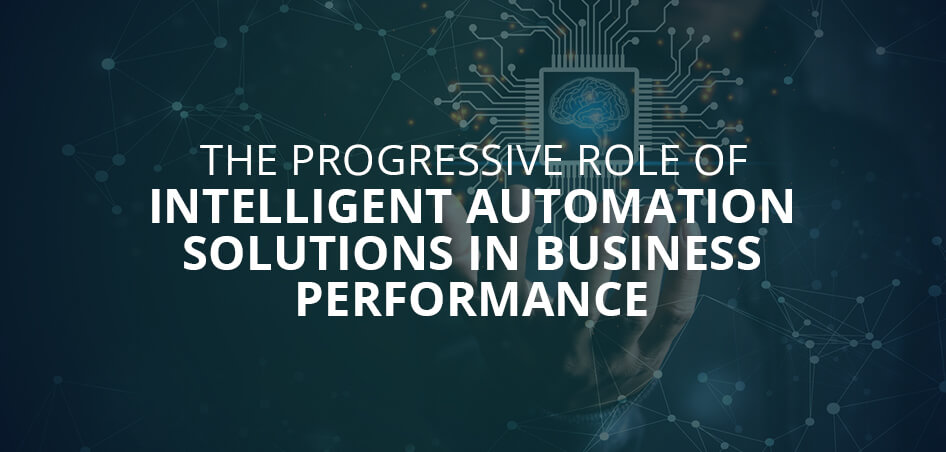
The progressive role of intelligent automation solutions in business performance
With the ever-changing nature of today's business environment, adopting intelligent automation solutions is no longer only advantageous—it is now essential for businesses hoping to stay competitive. Intelligent automation is a catch-all word for a range of cutting-edge technologies such as machine learning, robotic process automation, and artificial intelligence. It acts as a catalyst to redefine traditional operational frameworks and business processes. Over 80% of corporate executives of business leaders said they are speeding up the work process automation.
With companies facing a more complex range of opportunities and problems, integrating intelligent automation becomes a game-changing means of enhancing productivity, stimulating creativity, and developing flexibility. Intelligent automation has many potential benefits, ranging from simplifying repetitive work to supporting data-driven decision-making and creating smooth consumer experiences. However, despite these technologies' attraction, there are also built-in issues that need to be carefully considered and strategically foreseen, such as organizational inertia, integration complexities, and ethical quandaries.
Here is an article to understand how any expertise can successfully navigate the intricacies of the digital age. Hence, it is crucial to have a thorough understanding of the fundamentals of intelligent automation and how it affects businesses in this ever-changing environment.
How Intelligent automation technologies are segmented into broad categories?
Robotic Process Automation (RPA) uses structured data to mimic human activities for repetitive jobs, particularly clerical or administrative work. It easily combines with the programs and processes that are already in place. Using methods like optical character recognition and image recognition, smart data capture technology extracts various data inputs, including documents, text, and photographs.
Conversational interfaces, such as virtual assistants and chatbots, imitate human speech and use artificial intelligence to enhance user interactions. To effectively direct discussions, they examine historical data as well as fresh thoughts. Like healthtech expert with the ability to dynamically adjust based on contextual awareness, cognitive automation analyses complicated healthcare data can smartly deliver real-time insights, forecasts, and suggestions.
Agile orchestration integrates different technologies such as AI and process automation while synchronizing current systems, human workers, and intelligent automation tools. Effective process execution and adaptability are ensured by its constant monitoring of ongoing work, real-time identification of resource restrictions, and proactive action for addressing them
Steps Incorporating intelligent automation into digital transformation effectively
We suggest using a strong framework to incorporate automation into business strategies and digital transformation. To ensure that automation is in line with organizational objectives, this framework outlines essential IT and digital business competencies.
Team Development:
The deployment of intelligent automation requires the creation of a specialized organizational unit with a multidisciplinary team that possesses a variety of critical competencies. Members with strong leadership and political intelligence, competence in business analysis and design, and technical development experience should all be on this multidisciplinary team.
Enhance Skillsets:
Businesses need to add a variety of new skills to their old skill sets to fully reap the benefits of intelligent automation. These include expertise in customer experience optimization, process optimization, social media management, data science, subtle understanding of business operations, mastery of design thinking principles, strategic acumen, ability to foster creativity and innovation, and a strong preference for change management.
Heat Maps:
It is recommended for producing an extensive heat map that highlights regions most suited for the implementation of each automation technology. With the use of this tactical tool, one can maximize profits and optimize resource allocation by prioritizing investments and focusing on the most profitable prospects.
Strategic Foresight:
It's crucial to understand that automation solutions have much more value than just automating specific processes when putting them into practice. The enterprise gains wider advantages from these solutions, such as improved revenue production, increased organizational agility, and improved customer interactions. Initiatives stay in line with the broader strategic objective when the general impact of automation on business operations and shareholder value is kept in mind.
Conclusion
A range of advanced technologies designed to automate and expedite processes that have traditionally required human participation and judgement as well as routine, rule-based transactions are together referred to as intelligent automation. Optimizing the advantages of automation requires working in tandem with business process owners to identify and seize the most profitable opportunities as well as developing a deep understanding of intelligent automation solutions and keeping up with their swift progress.
Amtex provides tremendous assistance in this endeavor. As a leading benchmarking company and intellectual technology-based strategic consulting pioneer, we enable our clients to achieve success by recognizing and implementing automation best practices . Our area of expertise involves assisting companies implement the best technology practices so they may reach their fullest potential.





 Back
Back 31
31  74
74